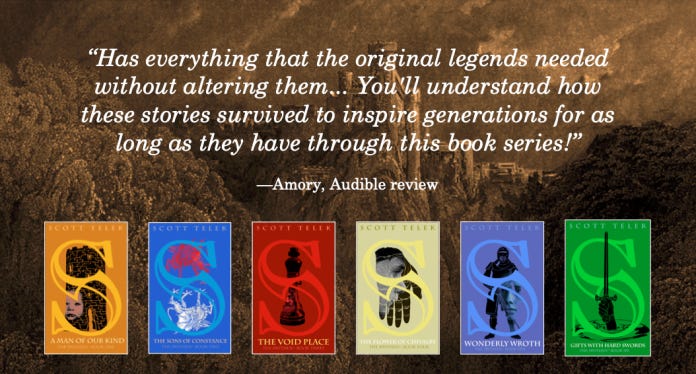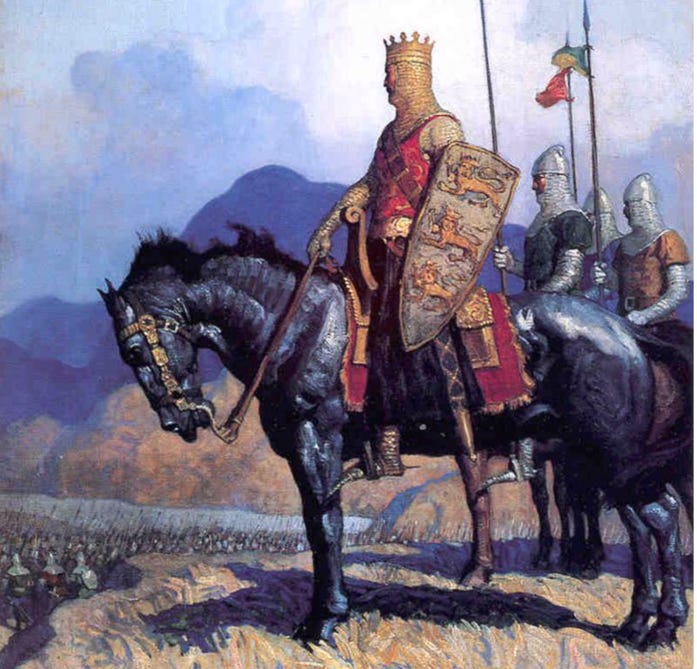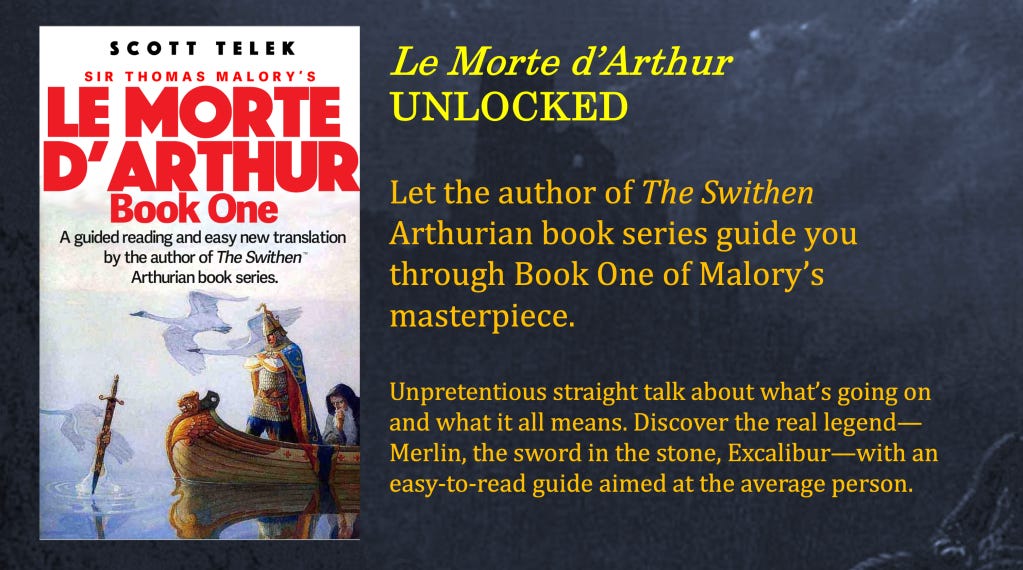Le Morte d'Arthur Guided Reading Part 1: What is Le Morte d'Arthur?
Let's start reading Sir Thomas Malory's masterwork together.
Hey there! You’ve reached the first installment of a series in which we’re going to go through Sir Thomas Malory’s Le Morte d’Arthur chapter by chapter and I’m going to help you understand what’s going on and what it all means. By the way, there is a companion book that contains the text of all the articles and videos, so if you want to get it all in one place, you can find it here.
We’re going to start reading Book One, but before we get started, we need to back up and delve into some of the background here. And you might think ‘Oh, this is just fluff, let’s get right to the book,’ but this stuff actually is important—which is why I’ve included it here! And why I’m telling you it’s important!
Let’s talk about what Le Morte d’Arthur is. So there probably was a person named Arthur, and he probably lived around 550. Many people get very hung up on whether Arthur really lived and the whole history of it—as if it would be invalid if it were just legend and mythology—but I don’t want to get into all that. We are focused on the literature that resulted.
The origins of the legend
The first written version of this story appears in 1136. So that’s about 600 years in which his story developed as a legend, that is, invented stories that are attributed to a real person, which is what makes this a real legend in the true sense, not in the Zack Snyder sense or the ‘legendary savings on data plans,’ kind of way. These stories were initially told by storytellers, just like you see in movies, because at that time most people could not read. So all of it was spoken,stories told by storytellers, and 1136 was the first time it was written down.
After that, we started having a bunch of different stories written at different times, in different countries, by different people. I have a video on YouTube on my channel @theswithenbookseries called How Did the Arthurian Legend Develop?, and if you want more detail you can go check that one out. One person added Lancelot. One person added the Grail. Someone at a later time turned that into the Holy Grail. The thing is, it was never conceived of as one complete and cohesive story.
So stop here. You might be—as I once was—thinking you’re going to skip all the BS and go straight to the source. You’re going to read Le Morte d’Arthur and find out the one, real story of King Arthur, straight from the horse’s mouth. And the first thing you have to realize is: there is no one, real story of King Arthur. There are a bunch of different stories by different people at different times that have been haphazardly stitched together into a barely coherent narrative.
The first full saga
In the 1200s there was the Vulgate and Post-Vulgate Cycles, which made an attempt to cram all the various stories into one cohesive narrative. Altogether, it’s about 3,200 pages. What it also does is take a story that began as a pagan legend and turn it into an explicitly Christian narrative. It adds the Holy Grail, understood openly as the cup that contained the blood of Christ. It wasn’t always that way in the story. It also added the moral shift toward Lancelot and especially his son Galahad, and away from Arthur himself, who is earthy and violent and not that great as a Christian hero. But in doing so, it bakes in this incredible dichotomy that makes the story so unbelievably powerful: that our hero, King Arthur, gets essentially disavowed three-quarters of the way through the story.
If you haven’t read the medieval stories of King Arthur, you’re in for a treat, because it is going to be very different than what you expect if you’ve only seen movies or TV shows. And while it might be less exciting and satisfying as a page-turner, it will be much more rich, thoughtful and transformative than you might imagine.
The creation of Le Morte d’Arthur
So almost 300 years after the Vulgate Cycle, in 1485, Sir Thomas Malory was in prison, and what he did, perhaps to pass the time, is he took different versions of the Arthurian legend, but especially the Vulgate and Post-Vulgate, and he made his own version of the complete story.
Malory’s Le Morte d’Arthur is only about 1,000 pages. So what happened to all that stuff in the larger story? The answer is: he left a lot of it out, and what he did leave in, he shortened to its bare bones. A lot of the reason it’s confusing to read is that Malory shortened it so much you sometimes lose the impact of what is happening—if you can understand what’s happening at all.
Another thing is that because we are stapling together bits of different stories written at different times by different people, there arise certain inherent contradictions. The whole thing does not hang together coherently, but its very incoherence grants it a certain kind of greatness. The cracks between stories, the missing connecting material, and the elements that are not fully explained leave space for thoughts and questions that only prove to make the whole thing more intriguing and evocative.
So when we read Le Morte d’Arthur, we are reading a jammed-together condensation of a much larger story, with a lot of pieces missing. Because of this, as we go through our guided reading, we’re going to talk about 1) what Malory left out, 2) the few things he put in, and 3) what it all means, i.e., the larger themes behind it all.
As we go forward, when I say the Vulgate, I mean the larger and longer story, which served as the primary source Malory adopted the tale from. It is all very relevant because the story Malory is telling is a shortened version, but the events of his story in many ways still occur in reaction to the larger tale. And when I say “Malory,” I mean Le Morte d’Arthur.

What I am doing in my book series The Swithen is writing a version of this tale across twenty-five novels, with the rule that I have to remain completely faithful to the medieval material, that is, I can’t “fix it” to make it more palatable to modern audiences, and I can’t rearrange it for more “wow” moments. It has to be authentic to the story up to Le Morte d’Arthur. I’m also taking pains to make these characters into real people and add psychology and character arcs to make us get into the story and understand the stakes. But anything I do add has to slot seamlessly into the existing legend without changing it. And that’s why I’ve read Le Morte d’Arthur and the Vulgate Cycle like a thousand times.
My translation is aimed at people who are coming to the Arthurian legend for the first time. Not scholars, but average people who just want to discover the King Arthur story for themselves. To this end, I have erred on the side of making it easy and readable. We might lose a bit of the poetry and the evocative sentence construction, but we will gain in simply being able to easily read and understand it.
That said, this is adapted from Middle English. Some words are just plain weird, some sentences in a strange order, some things simply will not make sense. That’s okay! After all, what does make sense these days? Just flow through it as best you can without getting hung up on any particular thing and you’ll be in a better place. Also, let’s leave the expectation that we are examining a lofty and unapproachable work of literature and just start going through the words and seeing how they strike you. Once you realize how many mistakes and rough transitions are still in the text, you won’t be so intimidated.
My translation is based off the William Caxton version, which is the version most people have known over the years, and I have never been unhappy with, and not the Winchester Manuscript, which is Malory’s unedited version. So what you’re about to delve into with Le Morte d’Arthur is a huge-scale, monumental work about life itself. It provides you with a great mind trip full of moral quandaries and cosmic ironies, it contains beautiful poetic language and incredibly rich insights. And it is a saga in the true sense of the word. It covers about a seventy years and has over fifty characters whose stories all interweave and build over the entire thing to one incredibly complex and shattering climax. And we’re going to dive into it together, so let’s go!





Brilliant introduction. I have wanted to read Mallory but always felt too intimated. Now I am feeling more courageous!!! Let’s go!